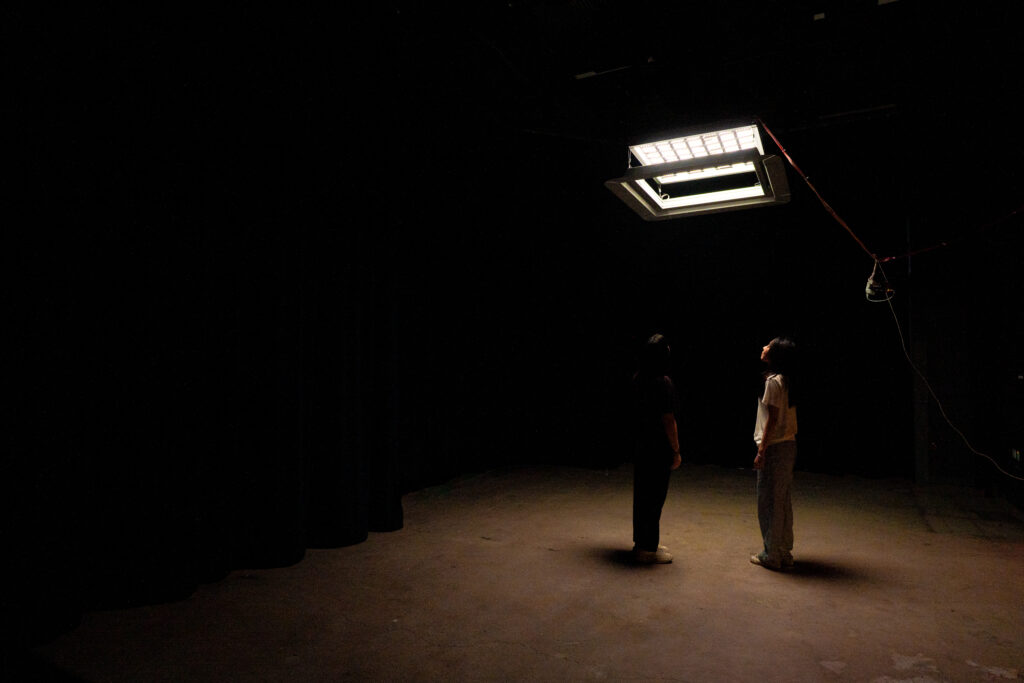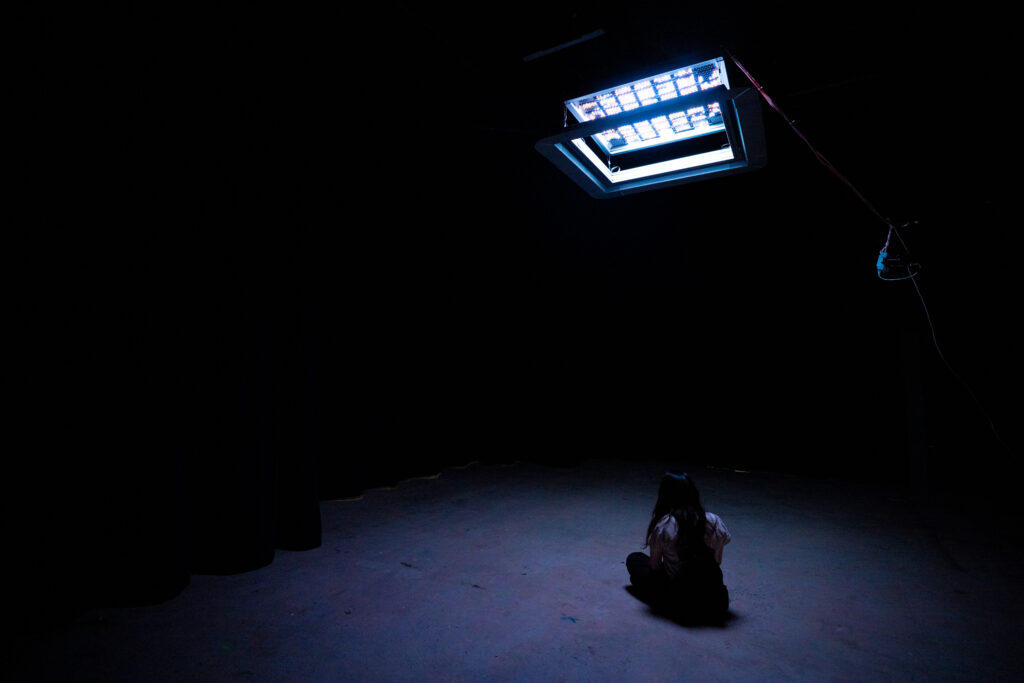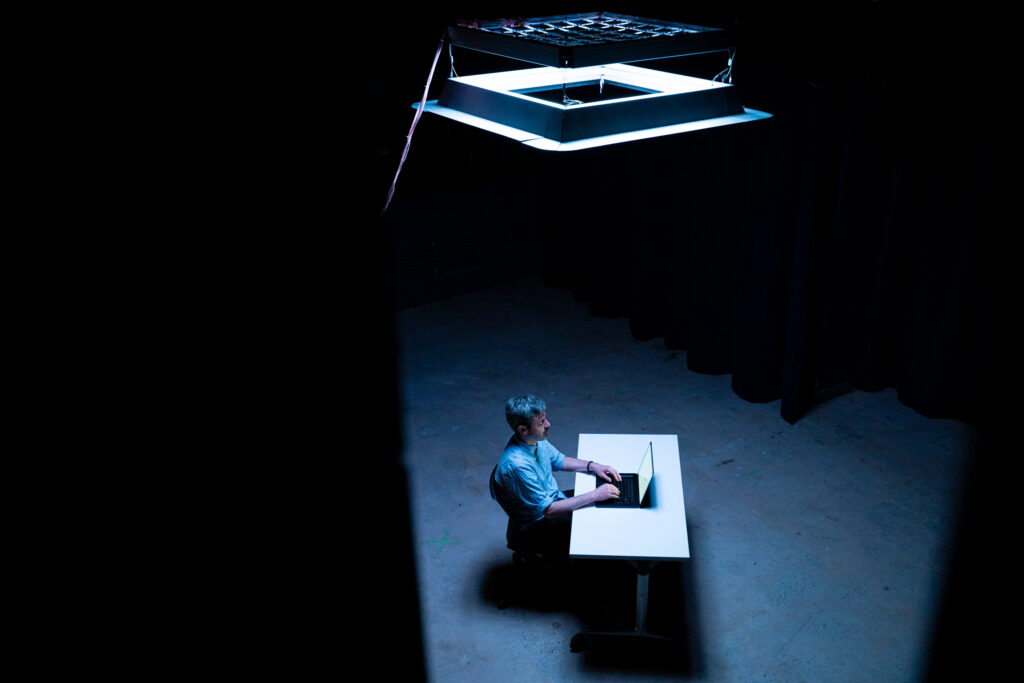Ambi(latent) Space
Matthew Lau
Advisor: Simone Salvo
Ambi(latent) Space demonstrates how machine learning can be meaningfully integrated into everyday objects, creating intelligent lighting that balances human-centric principles with personal aesthetic preferences. By processing images into responsive lighting environments, it explores a new approach to accessible, sustainable AI that enhances rather than overshadows physical spaces.

Project Description
Ambi(latent) Space is a lighting fixture that represents an approach to integrating machine learning into everyday environments. The fixture acts as both a functional light source and a demonstration of machine learning principles through an intelligent lighting system that, in addition to providing illumination, uses images by processing them through an algorithm that distils complex visual data into colour palettes that turn into responsive lighting environments based on human-centric lighting principles.
As the ephemerality of light is fleeting but it has the ability to encapsulate memories and evoke emotions through an intangible presence — there are three versions of Ambi(latent) Space currently on display. The first version displays UMAPs of images used to created colour palettes to shape a space, the second simulates sunlight in a day light circle meant to help shift people's circadian rhythm in changing seasons and the last is a based on the concept of following the sun and office culture and working across timezones.
The project serves as an exploration of an emerging category of intelligent objects that balance functionality and automation with co-creation between humans and machines. By demonstrating how AI can enhance everyday experiences without requiring massive infrastructure, the project challenges conventional assumptions about the resource requirements of intelligent systems. It suggests a future where machine learning becomes more accessible, sustainable, and integrated into the physical world — enhancing environments through subtle, responsive adaptations rather than overpowering them with technology.

Technical Details
The fixture is controlled by an Arduino Portenta H7, which operates a Tiny Machine Learning Model running directly on the edge device while simultaneously controlling the custom LED matrix that produces the actual lighting effects. This TinyML model has been trained on human-centric lighting principles, incorporating research on how different lighting characteristics affect human physiology and psychology. While the model understands optimal light temperatures and intensities for various times of day—such as cooler, brighter light for daytime alertness and warmer, dimmer lighting for evening relaxation—it doesn't rigidly impose these settings. Instead, the system creates a dynamic balance between optimal lighting and user aesthetic preferences. The colour input from user-selected images significantly influences the final lighting output, creating a collaborative relationship between human choices and machine intelligence. As the model detects colour palettes from the images that might contradict traditional lighting recommendations, it negotiates a middle ground, subtly blending human-centric lighting principles with the user's visual preferences. This co-creative process means the lighting evolves in each environment based on the specific images shared with the system. The TinyML model learns to recognize patterns in these selections over time, developing an understanding of when to prioritize strict lighting principles and when to favour the emotional or aesthetic qualities of user-preferred colour schemes, resulting in lighting that feels both personalized and biologically supportive.
Input colours are generated from a commonly used in Machine Learning called Uniform Manifold Approximation and Projection (UMAP). UMAP transforms the high-dimensional colour data from images (where each pixel contains multiple values for colour channels) into a simplified two-dimensional representation while preserving the relationships between colours. This means similar colours in the original image remain grouped together in the reduced form. UMAP identifies the underlying patterns and structure in the complex colour information, essentially creating a "map" where colours with similar properties appear close together and dissimilar colours appear far apart. The system generates an algorithmic plot clustering these colours by similar qualities, distilling the essence of the image's colour palette while maintaining meaningful relationships between different colour groups. This reduced representation allows the fixture to work with manageable data that captures the most important colour patterns from the original images, which can then be translated into lighting schemes.
The microcontroller continuously analyzes environmental conditions using a and time data, combining this information with learned user preferences to make real-time adjustments to the LED matrix. Each LED in the custom matrix uses SK6812 RGBW LEDs and can be individually addressed, allowing for control over colour, intensity, and distribution patterns across the fixture. This granular control enables the system to create nuanced lighting environments that seamlessly blend lighting principles with aesthetic preferences derived from the analyzed images. By integrating these capabilities on the microcontroller core, the fixture maintains responsive performance without connectivity delays, ensures privacy by keeping all processing local, and is energy efficiency compared to cloud-based smart lighting solutions. The direct connection between the machine learning model and the LED control system also enables the visual representation of the learning process, as patterns in the light output directly reflect the algorithmic decisions being made in real time.

Research/Context
The fixture is designed as a Pendant Architectural Lighting Fixture with a rectilinear structure focusing on linear geometry and material contrast with a post-modern aesthetic. The fixture consists of two hanging parallel aluminium and steel frames suspended by tension wires, creating a light gap in the middle and allowing for softer diffused light to escape between the frames and fall on the surface of the inverted lampshade while also allowing light to flood downwards into the space. The hanging frames create a floating effect making the fixture appear weightless while emphasizing the interplay of light and the structure. The rectilinear frames hint at the machine learning training process of dimension reduction, while the light gap and the intermixing of light from the LED matrix creates a neural network-esque visualization of data being recombined.
The fixture is designed as a Pendant Architectural Lighting Fixture with a rectilinear structure, emphasizing linear geometry, material contrast, and a post-modern aesthetic. It consists of two parallel aluminium and steel frames suspended by tension wires, creating a central light gap that allows for soft, diffused light to escape between the frames. This light gently illuminates the surface of the inverted lampshade while also flooding downward into the space. The floating effect of the hanging frames enhances the interplay between light and structure, making the fixture appear weightless. The bead-blasted aluminium and yellow-galvanized steel create a material contrast that enhances the light’s visual properties. The rectilinear frames, featuring a rounded rectangle nested within a square, subtly reference the machine learning process of dimensionality reduction, while the light gap and intermixing of light from the LED matrix evoke a neural network-like visualization of data being processed and recombined.
As the audience interacts with the system over time, the embedded machine learning model builds a nuanced understanding of colour preferences specific to the environment and its inhabitants. This learning occurs gradually as the system identifies patterns in the images it analyzes. The fixture might, for example, notice that cool blue tones are frequently set during morning hours, while warmer amber hues are more common in the evening hours.
While many AI applications rely on cloud computing and substantial energy consumption, the fixture employs "edge computing" principles — running a streamlined machine learning model directly on the device's microcontroller. Ambi(latent) Space provides a layer of visual transparency of artificial intelligence. As the system processes information and makes decisions, it reveals these internal operations through dynamic lighting schemes that illustrate different stages of the machine learning process. Users can witness subtle transitions between colour states that show how the algorithm clusters similar colours, prioritizes certain hues and adapts to changing conditions in real-time.
These visual cues transform what many consider an inscrutable "black box" of algorithmic decision-making into tangible, observable phenomena. Rather than keeping its computational processes hidden, Ambi(latent) Space exposes the inner workings of machine learning, helping to dissolve the perception of AI as something magical or incomprehensible. By making visible what typically remains invisible, the fixture invites people to develop a more intuitive understanding of how machine learning systems observe, process, and respond to their environments by putting them inside the proverbial black box.




